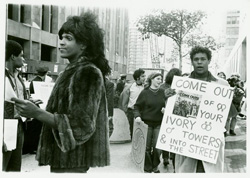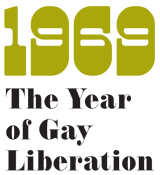Street Transvestites Action Revolutionaries (STAR)
 |
Queens Banding Together
Marsha P. Johnson handing out flyers in support of gay
students at New York University, 1970. Photograph by
Diana Davies.
NYPL, Manuscripts and Archives Division, Diana Davies Papers. Copyright Diana
Davies.
Digital ID: 1582220 |
The Gay Liberation Front and Gay Activists Alliance attracted
the attention of transvestites and transsexuals, as well as gays
and lesbians. Transvestites and transsexuals were a particularly
vulnerable group. In addition to social oppression and the constant
threat of violence, transvestism itself was illegal in New York.
Pioneering drag queens such as Sylvia Rivera and Marsha P. Johnson — both
veterans of the Stonewall Riots — were active on the front
lines of both GLF and GAA. They also started their own organization:
Street Transvestites Action Revolutionaries (STAR).
Sylvia and Marsha were deeply concerned about the dangers faced
by their fellow transvestites, who were often forced to pursue
prostitution to support themselves. As STAR, they created a collective
and shelter for transgender people. The first shelter, which they
started in an abandoned tractor trailer, went mythically awry
when the owner recovered the trailer and drove off with the queens
inside. STAR then moved on to renovate a burned-out building on
the Lower East Side. The queens banded together as a collective — sharing
food, money, and their lives.
Although the collective and STAR were short lived, Sylvia and
Marsha continued their activism, and their dramatic lives became
major symbols for the radicalism of this period. Their efforts
paved the way for later transgender activists, such as Lee Brewster,
a former Mattachine member, who created the Queens Liberation
Front later in 1970 and ran Lee's Mardi Gras, the premier drag
emporium in New York City, for decades. The Queens Liberation
Front successfully fought the anti-transvestism laws in New York,
which were struck down in 1971.

